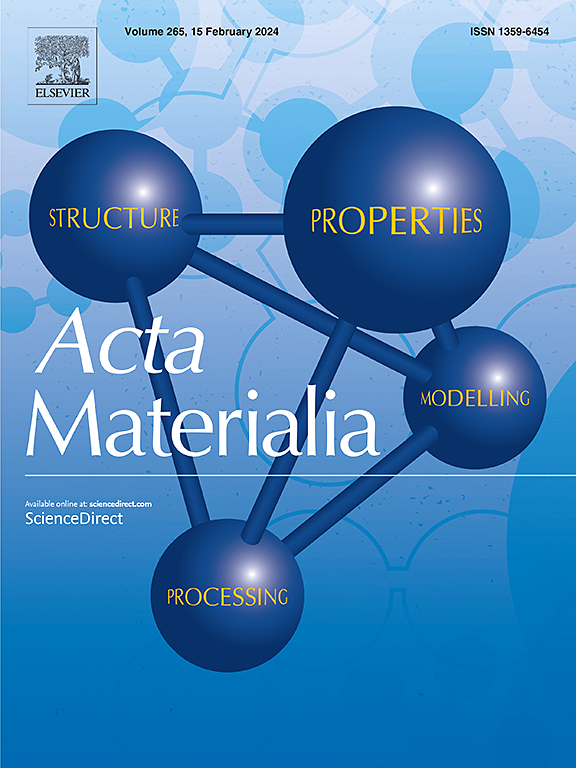Ag和Se共掺杂抑制Cu-S体系中离子迁移和提高热电性能的空间约束
IF 9.3
1区 材料科学
Q1 MATERIALS SCIENCE, MULTIDISCIPLINARY
引用次数: 0
摘要
Cu-S超离子化合物在中温区表现出优异的热电性能。然而,在该系统中获得热稳定性和电稳定性的材料仍然具有挑战性。本文从空间约束抑制Cu+迁移的角度出发,设计了Ag和Ag- se共掺杂策略来调节原始Cu1.93S的晶体结构。一方面,发现银掺杂剂作为空位填充剂,同时优化载流子浓度和降低导热系数。此外,战略性Se共取代稳定了Cu-S空位内的Ag插入,并诱导了不可忽略的声子散射增强,从而进一步降低了导热系数。在当前最先进的Cu-S体系中,在相对适中的温度下,Cu1.93Ag0.04S0.9Se0.1样品的竞争峰值zT为1.33@873K。此外,由于空间位限,Cu1.93Ag0.04S0.9Se0.1在动态直流电流下的电稳定性优于CuxS (1.93<x<1.97),表明Ag和Ag- se共掺杂可以有效抑制Cu+的电迁移。此外,Cu1.93Ag0.04S0.9Se0.1的热稳定性得到了改善,这是由于渗过的Ag通过加强化学键来限制硫的蒸发。此外,一项第一性原理研究表明,Ag和Se的加入与它们最近的邻居产生了新的电子相互作用,并通过增加原子间距离改变了局部原子环境,这有助于限制Cu的扩散和提高热电稳定性。通过在Cu1.93AgxS1-ySey体系中插入Ag和掺杂Se的空间约束方法,我们实现了高TE性能和显著的热稳定性和电稳定性的理想结合。本文章由计算机程序翻译,如有差异,请以英文原文为准。


Steric confinement for suppressing ion migration and boosting thermoelectric performance in Cu–S system via Ag and Se co-doping
The Cu-S superionic compound exhibits excellent thermoelectric (TE) performance in the mid-temperature region. However, obtaining a thermally and electrically stable material in this system is still challenging. Herein, motivated by the perspective of steric confinement for suppressing Cu+ migration, we designed an Ag and Ag-Se co-doping strategy on pristine Cu1.93S to modulate the crystal structure. On one hand, Ag dopant is discovered to act as a vacancy filler, simultaneously optimizing carrier concentration and reducing thermal conductivity. Moreover, strategic Se co-substitution stabilizes Ag insertion within the Cu-S vacancy and induces non-negligible enhancement of phonon scattering to further reduce thermal conductivity. A competitive peak zT of 1.33@873 K was obtained for the Cu1.93Ag0.04S0.9Se0.1 sample at a relatively moderate temperature among current state-of-the-art Cu-S system. Moreover, thanks to the steric confinement, the Cu1.93Ag0.04S0.9Se0.1 composition exhibited superior electrical stability under dynamic DC-current compared to CuxS (with 1.93<x<1.97), indicating that Ag and Ag-Se co-doping are effective at suppressing the electromigration of Cu+. Furthermore, an improved thermal stability of Cu1.93Ag0.04S0.9Se0.1 was attributed to percolated Ag which confines sulfur evaporation by strengthening the chemical bonding. In addition, a first-principles study demonstrates that the addition of Ag and Se creates new electronic interactions with their nearest neighbors and also modifies the local atomic environment by increasing interatomic distances, which contributes to limiting Cu diffusion and improving thermoelectric stability. Through the method of steric confinement via Ag insertion and Se doping in the Cu1.93AgxS1-ySey system, we achieved a desirable combination of high TE performance and notable thermal and electrical stability.
求助全文
通过发布文献求助,成功后即可免费获取论文全文。
去求助
来源期刊

Acta Materialia
工程技术-材料科学:综合
CiteScore
16.10
自引率
8.50%
发文量
801
审稿时长
53 days
期刊介绍:
Acta Materialia serves as a platform for publishing full-length, original papers and commissioned overviews that contribute to a profound understanding of the correlation between the processing, structure, and properties of inorganic materials. The journal seeks papers with high impact potential or those that significantly propel the field forward. The scope includes the atomic and molecular arrangements, chemical and electronic structures, and microstructure of materials, focusing on their mechanical or functional behavior across all length scales, including nanostructures.
 求助内容:
求助内容: 应助结果提醒方式:
应助结果提醒方式:


